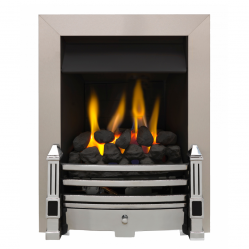Technical Details
| Product Title | Kohlangaz Delamere SC Gas Fire, Coal Effect, Conventional Flue |
|---|---|
| Product Keyword | Kohlangaz Delamere SC, Gas Fire, Coal Effect, Conventional Flue, Fireplace Insert |
| Energy Efficiency | F |
| Output (Nominal) | 2.1kW |
| Output (Maximum) | 4.2kW |
| Fuel | Gas - NG |
| Height | 548mm |
| Width | 365mm |
| Depth | 170mm |
| Nominal Output (Range) | 1kW - 3kW |
| Width (Range) | 400mm - 500mm |
| Nett Efficiency (%) | 63% |
| Style | Traditional |
| Chimney Type | Class 1 & 2 |
| Height (Range) | 500mm - 600mm |
Product Description
Kohlangaz Delamere SC Gas Fire
The Kohlangaz Delamere SC Gas Fire is an elegant and efficient heating solution for your home. With a realistic coal effect and a conventional flue system, this gas fire combines traditional aesthetics with modern functionality.
- Realistic Coal Effect: Enjoy the look of a real coal fire with none of the mess.
- Conventional Flue: Easily integrates with existing chimney systems.
- Slide Control: Control your fire's settings conveniently with a slide control mechanism.
- Efficiency: High efficiency up to 60%, ensuring you get the most heat out of the fuel consumed.
- Heat Output: A generous heat output of up to 3.3kW, keeping your room cozy and warm.
- Gas Type: Compatible with Natural Gas.
- Safety Features: Includes safety devices such as flame failure device and oxygen depletion sensor.
- Easy Installation: Designed for ease of installation in a variety of settings.
- Warranty: Comes with a manufacturer's warranty for peace of mind.
- Dimensions: Suitable for a variety of fireplaces, please check dimensions for fit.
- Customisable Options: Available in different finishes to match your decor.
Reviews
Fires & Fireplaces > Gas Fires

Gas Fires
Gas fires, just like their stove equivalent, can be a great addition to any home where space is limited and freestanding gas stoves or woodburners are not suitable options. Gas fires come in a wide array of styles, designs, sizes and outputs, providing customers with more choice and variations therefore ensuring there really is something for everyone! They are a great option for homes which do not have a chimney breast or do not have the space for a freestanding appliance, as they often are available with fireplace surrounds and so can usually be installed on any wall. This also reduces he installation time (usually) as there will often be less remedial work to be carried out when installing a gas fire, compared to a woodburner or freestanding gas stove.
The main difference between a gas fire and a gas stove is that gas stoves tend to be enclosed within a stove body, being designed to look as close to a woodburning stove as possible. Gas fires however, are generally designed to replicate an open fire, with no casing surrounding the appliance, rather it is designed to look ‘inserted’ into a wall with a fireplace surround. Just like with gas stoves, gas fires come with different ‘effects’ to choose from, such as coal effect or log effect, and many even have different flame settings, enabling you to control the output and temperature of the room.
If you are interested in gas fires, come and speak with us at Firebox Stoves and we can advise you on all aspects of installing and using a gas fire. We understand the huge range of options available in todays market and we can help you find anything, from traditional to contemporary gas fires, with balanced or contemporary flue options, and different flame effects and operating options. We can also supply large gas fires with high outputs, perfect for heating larger rooms and also some of the smallest gas fires, perfect for heating small rooms or topping up heat in rooms with existing appliances.





